Chocolate Holidays Around The World
Why Limit Yourself To Valentine’s Day? Celebrate Them All!
As a citizen of the [chocolate] world, you’re entitled to at least 20 chocolate holidays. Use them or lose them!
BEYOND CHOCOLATE: SEE ALL THE AMERICAN FOOD HOLIDAYS
If your chocolate celebration days are limited to Valentine’s Day and romantic birthday gifts, we’ve assembled a calendar that lets you celebrate other important chocolate holidays you’ve been overlooking.
With the help of some international celebrations, there’s a chocolate holiday in almost every month. In months that didn’t have an acknowledged chocolate holiday we’ve suggested one, because chocolate is too important not to celebrate it every month of the year.
1) January 1: New Year’s Day Around the World
Most people use New Year’s Day to make resolutions for self-improvement. Add to your other resolutions one to eat better chocolate, learn more about the components and history of chocolate, find new chocolatiers, and share your chocolate with others. Start a new tradition: the annual New Year’s Day Chocolate Tasting. Your friends may even give up the football game.
Net Cacao: One additional chocolate holiday. O.K., we made this one up; but as you’ll see, all it takes to make this one real is for a leading chocolate manufacturer to declare January 1 Chocolate Celebration Day.
2) February 14: Valentine’s Day in America, Europe and the Pac Rim
You know the drill in the U.S.A.: it’s the men who go a-wooing with heart-shaped red  velvet boxes of chocolate. But on February 14 in Japan, Korea and Taiwan it is the custom for women to bestow gifts of chocolate upon the men. Like being the only kid in grade school who doesn’t get a Valentine card, it is a source of embarrassment to Japanese men if they don’t receive any chocolates on Valentine’s Day (and Mom doesn’t count). To help them save face, Japanese women tend to give small gifts of giri-choco to most of the men around them—friends, co-workers, neighbors, relatives. Their special men receive a more elaborate gift of chocolate—sometimes homemade—called honmei-choco (honmei means “prospective winner,” and derives from the courting ritual). Giri means obligation and like Christmas gifts in the U.S., the obligation can be a financial burden. American ladies: adopt this custom wisely. (By the way, choco, which you’ve no doubt picked up as chocolate, is the shortened form of the Japanese word for chocolate, chokoreeto.) velvet boxes of chocolate. But on February 14 in Japan, Korea and Taiwan it is the custom for women to bestow gifts of chocolate upon the men. Like being the only kid in grade school who doesn’t get a Valentine card, it is a source of embarrassment to Japanese men if they don’t receive any chocolates on Valentine’s Day (and Mom doesn’t count). To help them save face, Japanese women tend to give small gifts of giri-choco to most of the men around them—friends, co-workers, neighbors, relatives. Their special men receive a more elaborate gift of chocolate—sometimes homemade—called honmei-choco (honmei means “prospective winner,” and derives from the courting ritual). Giri means obligation and like Christmas gifts in the U.S., the obligation can be a financial burden. American ladies: adopt this custom wisely. (By the way, choco, which you’ve no doubt picked up as chocolate, is the shortened form of the Japanese word for chocolate, chokoreeto.)
Chocolate heart box from Lake Champlain Chocolates.
Net Cacao: A partial chocolate holiday gained here, if you’re a man who hasn’t been getting his fair share on Valentine’s Day. And ladies, it opens the door to a second celebration for you next month.
3) March 14: White Day in Japan, Korea & Taiwan
One month after giving chocolate to their men on Valentine’s Day, it’s time for the 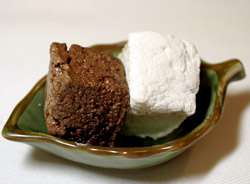 ladies to get their quid pro quo. This holiday was created in 1965 by a clever marshmallow maker that sought to sell more product, promoting to men that they should pay back with marshmallows the women who gave them Valentine chocolate. The chocolate companies soon realized that they could capitalize on this marketing bonanza, and began promoting white chocolate. Now, Japanese men give marshmallows, white chocolate, milk and dark chocolate, as well as other edible and non-edible gifts (like lingerie for wives and sweethearts) to the women who thought of them on Valentine’s Day. Many men, however, don’t reciprocate and give only to their girlfriends. Originally called “Marshmallow Day,” the holiday was later named White Day after the color of marshmallows. ladies to get their quid pro quo. This holiday was created in 1965 by a clever marshmallow maker that sought to sell more product, promoting to men that they should pay back with marshmallows the women who gave them Valentine chocolate. The chocolate companies soon realized that they could capitalize on this marketing bonanza, and began promoting white chocolate. Now, Japanese men give marshmallows, white chocolate, milk and dark chocolate, as well as other edible and non-edible gifts (like lingerie for wives and sweethearts) to the women who thought of them on Valentine’s Day. Many men, however, don’t reciprocate and give only to their girlfriends. Originally called “Marshmallow Day,” the holiday was later named White Day after the color of marshmallows.
Chocolate and vanilla marshmallows from Tiny Trapeze.
Net Cacao: One additional chocolate holiday. If you are a woman, you will receive chocolate; if you are a man, you will enjoy “testing” which chocolates to give.
The Mayans aligned their ceremonial buildings carefully with the compass directions. At the famous pyramid at Chichén Itza in Yucatan, something special happens on the equinoxes. The pyramid was built so that as the Sun rises and sets, the stairway on the north side is lit up at a steep angle, making the rim of the stairs look like a snake that is sliding up and down the pyramid. Look at the left side of the pyramid in the picture.
4) March: Vernal Equinox, Worldwide
The Vernal or Spring Equinox is a floating date, near March 20-21, when day and night are of equal lengths and the sun crosses the equator moving north (in the northern hemisphere). The Vernal Equinox marks the beginning of spring, longer days and shorter nights. The equinox was a marker to begin planting; and through the ages, festivals were held in villages with rituals and invocations for abundance in the new crops being planted. Today, the Vernal Equinox is a time of renewal, both in nature and in the home.
Net Cacao: One additional chocolate holiday and a good reason to invite friends to celebrate. If your circle doesn’t want to celebrate crops and nature with chocolate festivities, invite everyone to gear up for spring cleaning with an energizing chocolate fest.
5) April: Easter, Around the World
The Easter Bunny and his basket of treats for good boys and girls was first mentioned 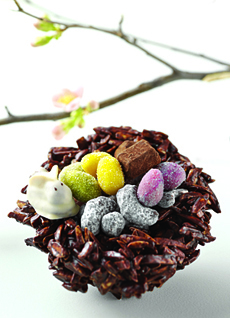 in German writings in the 1500’s—although chocolate as an Easter treat came later. It didn’t arrive in Spain until 1527, in drinking form, and wasn’t made into the first bars until 1847 in England. The first molded chocolate Easter Bunnies and chocolate-crusted sugar eggs were created in Germany after then, adding to the store of colored eggs. (The eggs had long been used to celebrate Easter by Catholics and were adapted by German Protestants into the myth of the egg-laying Easter Bunny.) Colored eggs were were introduced to Americans by German settlers who arrived in Pennsylvania Dutch country in the 1700’s, followed in time by chocolate treats. The chocolates migrated to wherever Easter is celebrated. In Australia, the giving of chocolate Easter eggs is the country’s largest chocolate consumption occasion, and is not limited to children: last year each person in Australia ate an average of 10 eggs. in German writings in the 1500’s—although chocolate as an Easter treat came later. It didn’t arrive in Spain until 1527, in drinking form, and wasn’t made into the first bars until 1847 in England. The first molded chocolate Easter Bunnies and chocolate-crusted sugar eggs were created in Germany after then, adding to the store of colored eggs. (The eggs had long been used to celebrate Easter by Catholics and were adapted by German Protestants into the myth of the egg-laying Easter Bunny.) Colored eggs were were introduced to Americans by German settlers who arrived in Pennsylvania Dutch country in the 1700’s, followed in time by chocolate treats. The chocolates migrated to wherever Easter is celebrated. In Australia, the giving of chocolate Easter eggs is the country’s largest chocolate consumption occasion, and is not limited to children: last year each person in Australia ate an average of 10 eggs.
Rocher Nest from L.A. Burdick Chocolates.
Net Gain: One chocolate holiday, because you probably only think of Easter baskets for the kids. Reclaim your right to enjoy chocolate, especially the immensely delicious rabbits and eggs created by America’s best chocolatiers. Be inspired by the enthusiasm of Australians, and taste and compare chocolate eggs from ten different chocolatiers.
6) May: Mother's Day in the U.S.
If you’re a mother, you’re entitled to great chocolate on Mother’s Day—and if you’re the child who brings it, you’re entitled to share. If Mom really loves chocolate, show you care by finding her the very best of her favorites—be they truffles or chocolate covered pretzels.
Net Gain: One chocolate holiday. Jewelry is nice, as is a new appliance or a brunch at your favorite restaurant. But be sure to let your children know that those cards should come wrapped around boxes of fine chocolate.
7) June: Father’s Day in the U.S.
Ditto for dads.
Net Cacao: One additional chocolate holiday. Just tell everyone: buy chocolate, not ties.
8) July-August: Chocolate Dipped Fruit and Fondue Day in the U.S.
A floating day in July or August to celebrate chocolate and summer by enjoying sweet 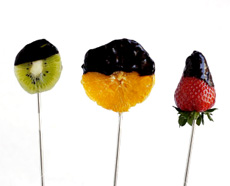 seasonal berries dipped in chocolate; and berries and other fruits and sweets dipped chocolate fondue. Yes, we made this holiday up; but only because the large chocolate companies aren’t on the ball like the Japanese marshmallow folks. seasonal berries dipped in chocolate; and berries and other fruits and sweets dipped chocolate fondue. Yes, we made this holiday up; but only because the large chocolate companies aren’t on the ball like the Japanese marshmallow folks.
Net Cacao: One additional chocolate holiday and a good reason to invite a group of friends for dessert.
9) September: Autumnal Equinox, Worldwide
The Autumnal or Fall Equinox is a floating date around September 22-23 that marks the first day of autumn, when day and night are of equal lengths. The sun crosses the equator moving southward (in the northern hemisphere). The Autumnal Equinox marks the beginning of shorter days and longer nights and the passage into winter. On this day, this day, the sun rises directly in the east and sets directly in the west; the sun will begin to rise at the South Pole after six months of darkness, to preside over six months of daylight; and the zenith passes directly overhead on the equator, so the sun casts no shadows. For centuries, friends have gathered to celebrate the day and strengthen their spirits in preparation for the passage into winter.
Net Cacao: One additional chocolate holiday and a good reason to invite friends to celebrate the harvest with a pot-luck chocolate evening.
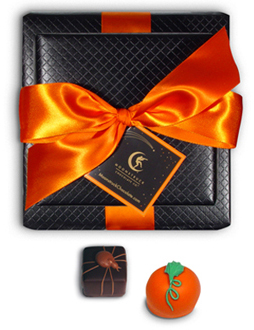 10) October 31: Halloween in the U.S. 10) October 31: Halloween in the U.S.
Just for kids, you say? Not when you see the beautiful treats made by great chocolatiers for celebrants with palates too sophisticated to dip into the Trick-or-Treat stash.
Box of Halloween candy from Moonstruck Chocolate.
Net Cacao: One additional chocolate holiday. Your added treat is checking out the websites of the best chocolatiers and ordering whatever you fancy.
11) -15) October/November: Diwali in India
Diwali (also called Divali or Deepavali), the “festival of lights,” is one of the longest Hindu religious festivals, spanning five days in the Hindu month of Karthika (late October/early November). It marks both a new moon and a new year and honors Lakshmi, the goddess of wealth and good fortune. Everything in India comes to a standstill except family life, feasting and shopping for clothes and gifts. Celebrants light five traditional clay oil lamps commemorating the triumph of good Prince Rama, who conquered the evil tyrant Ravana. Gifts of sweets are exchanged with neighbors and friends. A unique treat is chocolate molded into the shape of a diya, the clay oil lamp, which is decorated with edible paints, chocolate buttons and flakes in intricate traditional patterns and filled with goodies. Boxes of European-style chocolates are also exchanged.
Net Cacao: Five chocolate feasting days. Get plenty of rest.
16) - 18) October 31 - November 2: Day of the Dead in Mexico
Since pre-Colombian times, Mexican people have celebrated El Dia de los Muertos, a 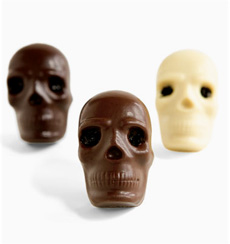 ritual in which the living remember their departed relatives. From October 31 through November 2, graves are tended and decorated with ofrendas, offerings, and families expect a visit from loved ones who have passed. Ofrendas dedicated to the deceased, usually foods and beverages, are also put in homes on elaborately decorated altars. Some people believe that the visiting spirits of the deceased eat the spirit of the food; thus friends and relatives eat the food from the ofrendas in tribute to the dead. Foods can include chocolate beverages, chicken with chocolate mole sauce, and sugar and chocolate skulls inscribed with the names of the deceased on the forehead. ritual in which the living remember their departed relatives. From October 31 through November 2, graves are tended and decorated with ofrendas, offerings, and families expect a visit from loved ones who have passed. Ofrendas dedicated to the deceased, usually foods and beverages, are also put in homes on elaborately decorated altars. Some people believe that the visiting spirits of the deceased eat the spirit of the food; thus friends and relatives eat the food from the ofrendas in tribute to the dead. Foods can include chocolate beverages, chicken with chocolate mole sauce, and sugar and chocolate skulls inscribed with the names of the deceased on the forehead.
Chocolates skulls, or calaveritas, from Vosges Haut Chocolat.
Net Cacao: Three chocolate eating days. Also use this opportunity to dine at an authentic Mexican restaurant (not Tex-Mex) and enjoy chicken with mole sauce.
19) December 24: Christmas Eve in France
Instead of gathering around the Christmas tree, French families gather around a Yule log burning in the fireplace. Sometime after 1870, a Parisian patissier was inspired by the festivity to create the first Bûche de Noël (“Christmas Log”), a chocolate frosted cake. To imitate the log, a roll of Genoise sponge cake is covered in chocolate buttercream that is textured to resemble bark. Smaller pieces of cake, also covered in buttercream, are affixed to the main roll to represent trimmed branches. The ends of the roll and the cut faces of the branches are frosted with vanilla cream to imitate cut wood. The log is decorated with holly leaves made of icing or marzipan, and meringue mushrooms. The presentation of the Bûche de Noël is the highlight of the French holiday meal.
Net Cacao: One chocolate eating day. With everything else going on on Christmas eve, this is a nice way to work chocolate into the day.
20+) December 25: Christmas Day, Everywhere
Instead of more things that you don’t need and don’t have space for, this is your 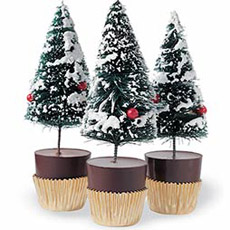 opportunity to ask for one or two boxes of luxury bonbons (not too much—remember, they have a two-week shelf life), a collection of fine bars for tasting and study (they’ll keep a year or more), and a variety of fine hot chocolates to keep you warm for the winter (a $25 and more per box, they’re something you may feel better about receiving than buying for yourself). While others will have forgotten their gifts by mid-January, you’ll be happy with yours through spring, at least. opportunity to ask for one or two boxes of luxury bonbons (not too much—remember, they have a two-week shelf life), a collection of fine bars for tasting and study (they’ll keep a year or more), and a variety of fine hot chocolates to keep you warm for the winter (a $25 and more per box, they’re something you may feel better about receiving than buying for yourself). While others will have forgotten their gifts by mid-January, you’ll be happy with yours through spring, at least.
Christmas tree place settings from Bissingers.
Net Cacao: One chocolate eating day today, with numerous more to follow. After the spiritual, gifting and dining events of Christmas are through, retire for some quiet contemplation with one of the boxes of fine chocolates you’ve received; end enjoy the rest as you celebrate the new year. Note to self: be sure to put everything you want on your Christmas list.
More Chocolate Holidays?
If they’re out there, we’re happy to consider them for the list. Click here to tell us about them. Even netting out the holidays we created, you have quite a few legitimate days to celebrate. Enjoy them
For more information about chocolate, visit our Chocolate Articles and Product Reviews section.
© Copyright 2005-2025 Lifestyle Direct Direct, Inc. All rights reserved. Images are the copyright of their respective owners.
|





 velvet boxes of chocolate. But on February 14 in Japan, Korea and Taiwan it is the custom for women to bestow gifts of chocolate upon the men. Like being the only kid in grade school who doesn’t get a Valentine card, it is a source of embarrassment to Japanese men if they don’t receive any chocolates on Valentine’s Day (and Mom doesn’t count). To help them save face, Japanese women tend to give small gifts of giri-choco to most of the men around them—friends, co-workers, neighbors, relatives. Their special men receive a more elaborate gift of chocolate—sometimes homemade—called honmei-choco (honmei means “prospective winner,” and derives from the courting ritual). Giri means obligation and like Christmas gifts in the U.S., the obligation can be a financial burden. American ladies: adopt this custom wisely. (By the way, choco, which you’ve no doubt picked up as chocolate, is the shortened form of the Japanese word for chocolate, chokoreeto.)
velvet boxes of chocolate. But on February 14 in Japan, Korea and Taiwan it is the custom for women to bestow gifts of chocolate upon the men. Like being the only kid in grade school who doesn’t get a Valentine card, it is a source of embarrassment to Japanese men if they don’t receive any chocolates on Valentine’s Day (and Mom doesn’t count). To help them save face, Japanese women tend to give small gifts of giri-choco to most of the men around them—friends, co-workers, neighbors, relatives. Their special men receive a more elaborate gift of chocolate—sometimes homemade—called honmei-choco (honmei means “prospective winner,” and derives from the courting ritual). Giri means obligation and like Christmas gifts in the U.S., the obligation can be a financial burden. American ladies: adopt this custom wisely. (By the way, choco, which you’ve no doubt picked up as chocolate, is the shortened form of the Japanese word for chocolate, chokoreeto.) ladies to get their quid pro quo. This holiday was created in 1965 by a clever marshmallow maker that sought to sell more product, promoting to men that they should pay back with marshmallows the women who gave them Valentine chocolate. The chocolate companies soon realized that they could capitalize on this marketing bonanza, and began promoting white chocolate. Now, Japanese men give marshmallows, white chocolate, milk and dark chocolate, as well as other edible and non-edible gifts (like lingerie for wives and sweethearts) to the women who thought of them on Valentine’s Day. Many men, however, don’t reciprocate and give only to their girlfriends. Originally called “Marshmallow Day,” the holiday was later named White Day after the color of marshmallows.
ladies to get their quid pro quo. This holiday was created in 1965 by a clever marshmallow maker that sought to sell more product, promoting to men that they should pay back with marshmallows the women who gave them Valentine chocolate. The chocolate companies soon realized that they could capitalize on this marketing bonanza, and began promoting white chocolate. Now, Japanese men give marshmallows, white chocolate, milk and dark chocolate, as well as other edible and non-edible gifts (like lingerie for wives and sweethearts) to the women who thought of them on Valentine’s Day. Many men, however, don’t reciprocate and give only to their girlfriends. Originally called “Marshmallow Day,” the holiday was later named White Day after the color of marshmallows. in German writings in the 1500’s—although chocolate as an Easter treat came later. It didn’t arrive in Spain until 1527, in drinking form, and wasn’t made into the first bars until 1847 in England. The first molded chocolate Easter Bunnies and chocolate-crusted sugar eggs were created in Germany after then, adding to the store of colored eggs. (The eggs had long been used to celebrate Easter by Catholics and were adapted by German Protestants into the myth of the egg-laying Easter Bunny.) Colored eggs were were introduced to Americans by German settlers who arrived in Pennsylvania Dutch country in the 1700’s, followed in time by chocolate treats. The chocolates migrated to wherever Easter is celebrated. In Australia, the giving of chocolate Easter eggs is the country’s largest chocolate consumption occasion, and is not limited to children: last year each person in Australia ate an average of 10 eggs.
in German writings in the 1500’s—although chocolate as an Easter treat came later. It didn’t arrive in Spain until 1527, in drinking form, and wasn’t made into the first bars until 1847 in England. The first molded chocolate Easter Bunnies and chocolate-crusted sugar eggs were created in Germany after then, adding to the store of colored eggs. (The eggs had long been used to celebrate Easter by Catholics and were adapted by German Protestants into the myth of the egg-laying Easter Bunny.) Colored eggs were were introduced to Americans by German settlers who arrived in Pennsylvania Dutch country in the 1700’s, followed in time by chocolate treats. The chocolates migrated to wherever Easter is celebrated. In Australia, the giving of chocolate Easter eggs is the country’s largest chocolate consumption occasion, and is not limited to children: last year each person in Australia ate an average of 10 eggs. 
 10) October 31: Halloween in the U.S.
10) October 31: Halloween in the U.S. ritual in which the living remember their departed relatives. From October 31 through November 2, graves are tended and decorated with ofrendas, offerings, and families expect a visit from loved ones who have passed. Ofrendas dedicated to the deceased, usually foods and beverages, are also put in homes on elaborately decorated altars. Some people believe that the visiting spirits of the deceased eat the spirit of the food; thus friends and relatives eat the food from the ofrendas in tribute to the dead. Foods can include chocolate beverages, chicken with chocolate mole sauce, and sugar and chocolate skulls inscribed with the names of the deceased on the forehead.
ritual in which the living remember their departed relatives. From October 31 through November 2, graves are tended and decorated with ofrendas, offerings, and families expect a visit from loved ones who have passed. Ofrendas dedicated to the deceased, usually foods and beverages, are also put in homes on elaborately decorated altars. Some people believe that the visiting spirits of the deceased eat the spirit of the food; thus friends and relatives eat the food from the ofrendas in tribute to the dead. Foods can include chocolate beverages, chicken with chocolate mole sauce, and sugar and chocolate skulls inscribed with the names of the deceased on the forehead.  opportunity to ask for one or two boxes of luxury bonbons (not too much—remember, they have a two-week shelf life), a collection of fine bars for tasting and study (they’ll keep a year or more), and a variety of fine hot chocolates to keep you warm for the winter (a $25 and more per box, they’re something you may feel better about receiving than buying for yourself). While others will have forgotten their gifts by mid-January, you’ll be happy with yours through spring, at least.
opportunity to ask for one or two boxes of luxury bonbons (not too much—remember, they have a two-week shelf life), a collection of fine bars for tasting and study (they’ll keep a year or more), and a variety of fine hot chocolates to keep you warm for the winter (a $25 and more per box, they’re something you may feel better about receiving than buying for yourself). While others will have forgotten their gifts by mid-January, you’ll be happy with yours through spring, at least.